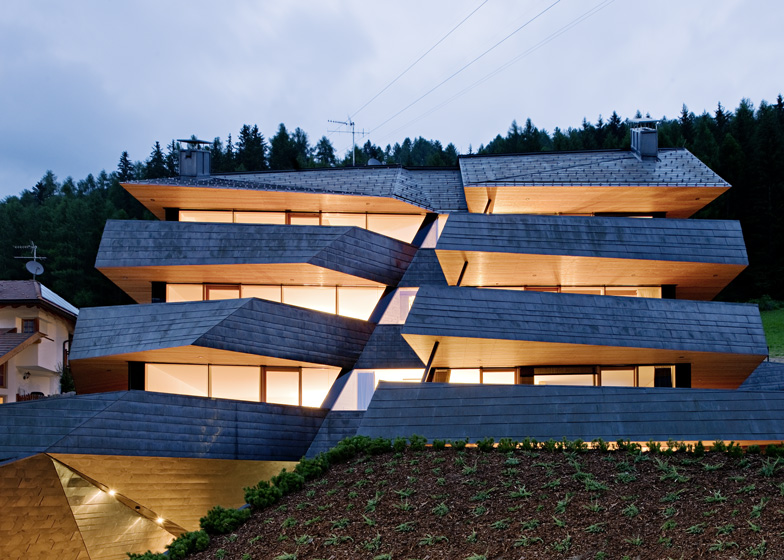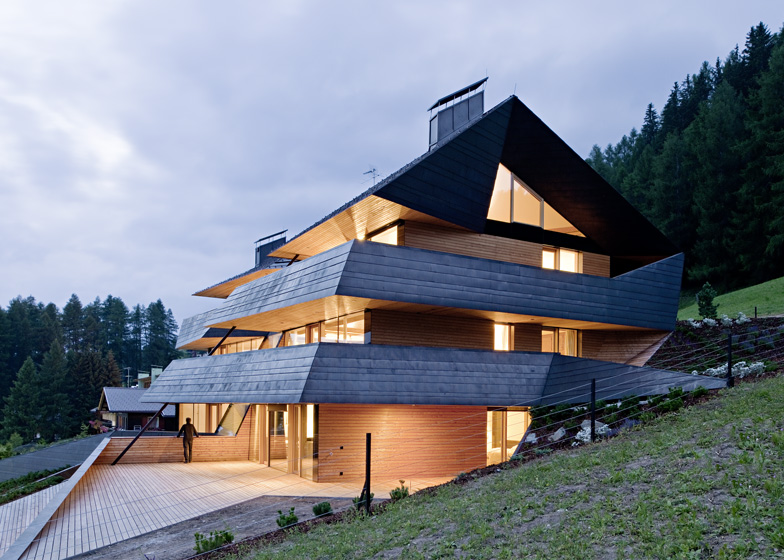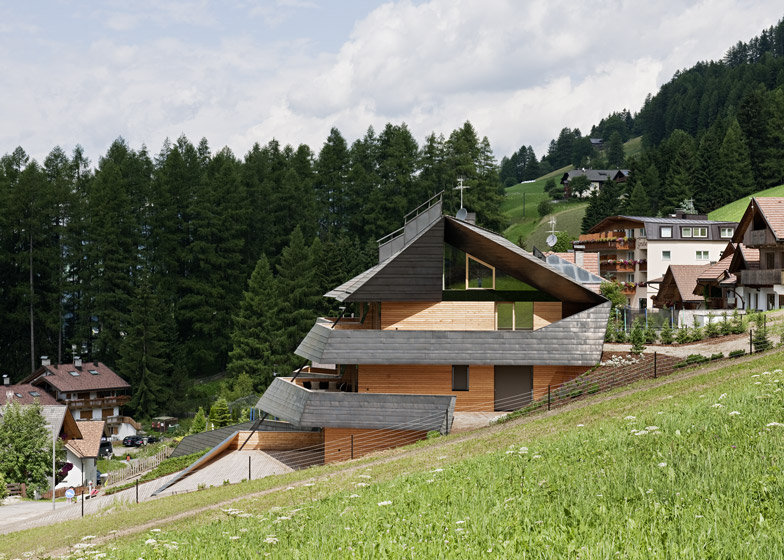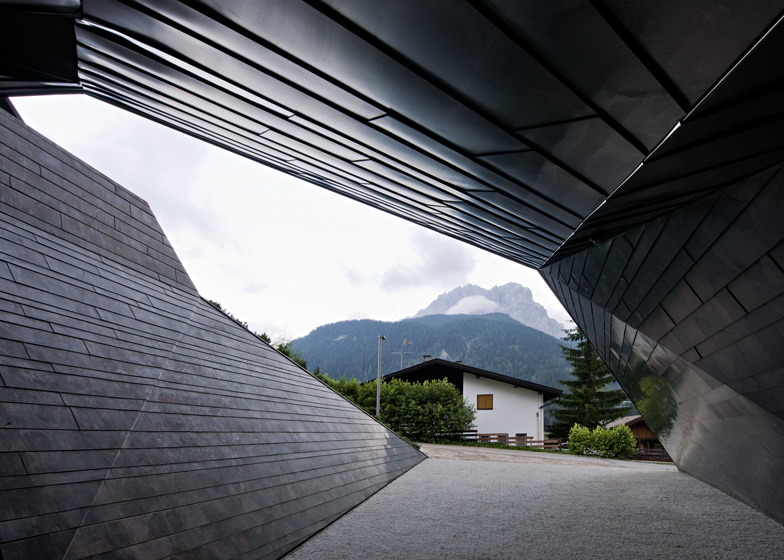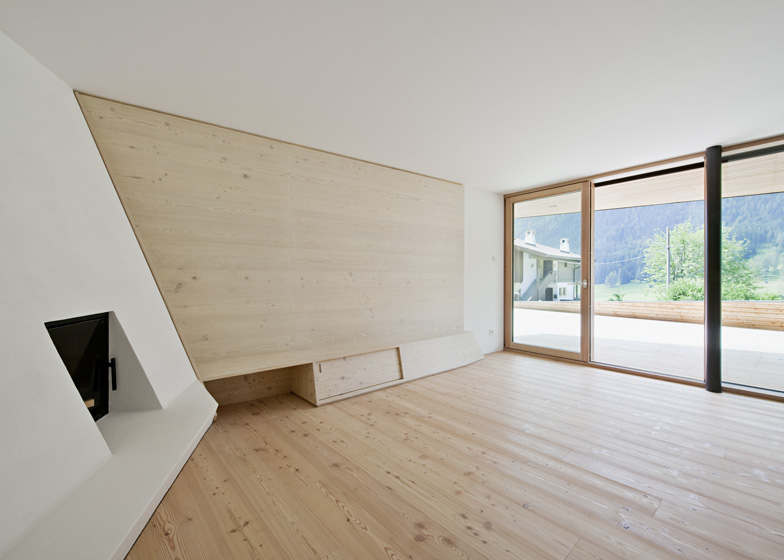Jagged copper balconies emulate the topography of surrounding landscape as they fold around the exterior of this apartment block in north-east Italy by architects Plasma Studio (+ slideshow).
Positioned beside the Dolomites, the three-storey Dolomitenblick building contains six holiday homes that each face north-east towards the mountains.
A diagonal recess slices down the centre of the facade, separating the balconies of different apartments and breaking down the volume of the building.
"This incision becomes the main defining element of the building," explains Plasma Studio. "From the cut at either side a strip unfolds that forms the balustrade of a generous covered balcony and ends into the surrounding topography."
The whole facade also slopes backwards to match the incline of the sloping land, finishing with an asymmetric interpretation of a traditional gabled roof, which the architects were asked to incorporate by the local planning authorities.
"Slightly deformed, it merges with our design intention but also with the traditional typology of pitched roofs," say the architects, explaining how they wanted to explore the "new potentials of a traditional typology".
Inspired by local farmhouses, the architects used larch to clad the walls behind the pre-oxidised copper balconies, as well as the floors and walls inside each apartment.
They also made various depressions into the ground, adding low-level windows and a tunnel leading into an underground parking area beneath the building.
Above: balconies design concept
Plasma Studio have completed a few buildings in northern Italy, including a hotel with stripy timber cladding and a housing block in South Tyrol. See all our stories about Plasma Studio »
Above: vertical incision design concept
Photography is by Hertha Hurnaus.
Here's some more information from the architects:
Dolomitenblick
The building is located on a hillside in the Dolomites, at the end of a residential area.
Above: location plan
The volume has been developed mainly from its pragmatic functional request to host 6 independent apartments with one common circulation: through a cut that marks the main access and the division of the units the volume is splitted into 2 halves. Besides its functional meaning this incision becomes the main defining element of the building: from the cut at either side a strip unfolds that forms the balustrade of a generous covered balcony and ends into the surrounding topography. Following the steep natural hillside with each floor the strips and the façade jump back.
Above: site plan
Programme
The building hosts 6 generous holiday homes, all directed to the sun and the panoramic view of the Dolomites. Each private unite is designed to get a maximum of privacy: through the division of the whole building volume into 2 parts, through the stepped balustrades which avoid insight from the above unit and from the passing by street. Each apartment gets an extension of the internal living area by a covered sun and view facing terrace which at each floor ends in a small private garden. Local larch wood defines internal and external living areas. Floor to ceiling glazing allows the maximum view and energetic gain as directed to south, external sun blinds and the overhangs of the above balconies minimize overheating during summertime.
Above: apartments level one plan
The main circulation is very compact and a continuation of the volume defining gap and repeats the use of the local larch wood and the color code of the façade.
Above: parking level plan
Material
Sitting at the edges of a residential area with a very eclectic and non-coherent appearance we focus to contrast these surroundings by simply generating a volume which grows out of its natural surrounding topography and blends again into it, by minimizing the used materials to a very local, almost vernacular code: larch wood and pre oxidised copper. Both the copper and the larch wood are exposed to a natural change of colour by the atmospheric influence of sun, rain and snow. Through the repetition of the colours of old, close-by farmhouses with dark, sunburned larchwood facades this building volumes blends into its natural surroundings.
Above: front elevation
Focus was given to the design of the copper balustrades which start from the natural topography, grow, become balustrades, attach to the building where the gap defines the volume, peel again off and end finally in the surrounding topography. When peeling off, the metal sheets which are divided into horizontal strips describe a curved hyperbolic-parabolic geometry: crafts knowledge is brought to its extreme.
Above: side elevation
The dark copper surrounds the volume from all sides, the strips form a second layer which gives shelter from and insight and finally define the roof as a continuation of the overall façade and volume. The form of the roof itself derives from local planning regulation which allows only a pitched roof in this specific building plot: slightly deformed, it merges with our design intention but also with the traditional typology of pitched roofs by not simply repeating but rather exploring what new potentials of a traditional typology can be.
Above: rear elevation
Project: residential building with 6 units and underground garage
Client: private
Size: 1.050 sq m
Location: Sexten / Sesto Italy
Completed: Summer 2012

